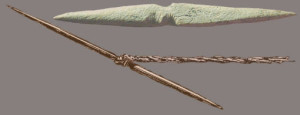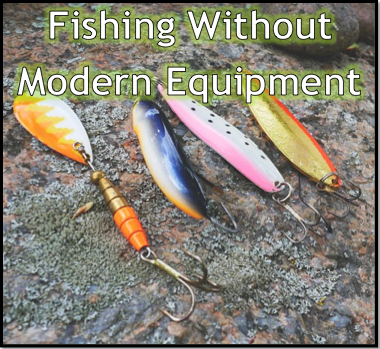Humans have been fishing for millennia and the methods used throughout history can be worth learning, especially for those who lean toward preparing for the unknown. To fish without modern equipment is not difficult in the sense of constructing what you need but the actual art of fishing can be a little more complex.
These days we have depth and fish finders, electric fishing reels, and different poles for different fish. In my own home, we have casting poles for both trout and salmon, salmon poles used with down riggers when trolling, and then the thicker, stronger halibut poles for bottom fishing. Then there are the net sizes to accommodate the fish you are going for. When you add up all the money spent, it climbs into the thousands quickly and that is before you start buying the fishing line and tackle. During our recent move to the new house, I thought about how fish used to be caught before there were all these gadgets.
Where I live, there are three Native tribes who relied on the salmon runs and food of the sea to survive, and I guarantee that they did not have a closet full of 8 different poles, boxes of tackle, and 3 different sized nets! Their methods back in the day were more simple and in some ways more effective. Their gear was also built by the people who used them and even small children knew how to make and use a gorge hook, help set up fish traps, and then help preserve the catch for the upcoming winter.
There is, of course, the idyllic scene of the boy in cut off pants fishing with a stick that has a line a little hook attached to it off the bank of a river. Depending on what you are fishing for, this is also a perfectly acceptable ‘primitive’ way to fish but what if you don’t have a hook? Or bait? What if you are stuck out in the wilds with nothing other than the clothes on your back and a knife? You can still fish! Heck, even if you don’t have a knife or line, you can truly still fish! Here are some of the items that primitive people made and used to catch food. Going from the most simple to more complex, just about everyone can build what they need to catch food and survive.
The Gorge Hook
 The gorge hook is incredibly simple to craft and use. You can make them out of wood, bones, antlers: anything that will hold up to a thrashing fish. At least, until you land it! Simply get a length of your material and whittle it down so it has sharp sides and a groove in the middle. The actual size will be determined by what kind of fish you’re going for. You want it to be large enough to be swallowed but not so small that it fails to gouge the sides and get stuck when pulled on. You also need to choose something strong enough to hold without breaking when fighting the fish. If it snaps with the first jerk on the line, that is a lot of time and energy wasted.
The gorge hook is incredibly simple to craft and use. You can make them out of wood, bones, antlers: anything that will hold up to a thrashing fish. At least, until you land it! Simply get a length of your material and whittle it down so it has sharp sides and a groove in the middle. The actual size will be determined by what kind of fish you’re going for. You want it to be large enough to be swallowed but not so small that it fails to gouge the sides and get stuck when pulled on. You also need to choose something strong enough to hold without breaking when fighting the fish. If it snaps with the first jerk on the line, that is a lot of time and energy wasted.
Almost all modern hooks are based on this ancient technology with stronger materials and variations.
The Barbed Hook
This style of hook mimics the gorge hook in that you want it to get lodged inside the fish. They can be a little tricker to make than the gorge hook but are still effective and will catch your dinner. Instead of the line being in the middle, it is on one end of the hook with the barb poking out and where you put the bait. The barbed hook uses the same principle as the gorge hook in that it gets lodged inside the fish’s mouth, gills, or throat and holds strong so you can land it. Thorns were often used as the barb part of the hook and tied on to the rest of the hook with twine or line.
Remember, it is your skills more than your gear that will see you through a disaster!
Spear Fishing
 Spear fishing is even older than using a hook and takes more skill, patience, and practice than using hooks and line (in my opinion). Before we ventured out into the oceans, humanity lived along the coasts of rivers and other inland water ways. In the shallower water, it was easier to see and therefore spear the fish. You had a better chance of seeing where they were and that usually meant a better chance of catching them.
Spear fishing is even older than using a hook and takes more skill, patience, and practice than using hooks and line (in my opinion). Before we ventured out into the oceans, humanity lived along the coasts of rivers and other inland water ways. In the shallower water, it was easier to see and therefore spear the fish. You had a better chance of seeing where they were and that usually meant a better chance of catching them.
A fishing spear can be anything from a stick with a sharp point to more elaborate trident styled tips. The concept here is simple: see a fish, take aim, try to pierce it and bring it on shore.
Fish Traps and Nets
Making fish traps is another option for catching fish: hopefully more than one at a time! Here in Southeast Alaska where there are salmon runs every year, the Alaskan Natives would set up poles in the sand and rock at low tide, creating a wall. As the tide came up, the fish came in and over the barrier but as the tide went back out, they would be trapped on one side of the wall. Fish traps of this style were banned in 1959 in the state of Alaska but if the way of life as we know it were to change for the long term, it would again be a viable way to get a lot of food for a lot of people at once.
Other styles of fish traps include the weaving of branches in a large basket that is open on one end for the fish to swim in and designed so they cannot swim out. These days, smaller fish must be able to swim through the trap without harm to ensure continuation of the species. You can also weave nets out of various resources found in the woods: cedar bark, braided grass, or green branches. Find a bottleneck in the river or stream and lay it across with weights to keep it straight up and down. Putting something that floats on the top will also help it keep its shape and keep it from folding over or getting wonky that will allow fish through.
With just a little practice at making primitive fishing gear, and trying you hand at using them, you will have gained some invaluable skills that could not only fill your belly but can be done as a family! Learning how to catch the smaller fish (used for bait to get the larger fish) is a great way to practice!





I have always been a fan of the fish traps. We used to test some out in the springs around my house. Set up a funnel that directs them in and then the could not find their way out. Worked like a charm.
The natives here would put large sticks or small tree trunks into the ground. At high tide, the water goes over the tops of them and when it goes back out, fish are trapped! Worked very well for them. Of course, there are no such traps anymore since everything is regulated. Thanks for the comment!
I made hooks out of thorns from some sort of wild apple tree that grew down by the creek. I saw an example in the Boy Scout “Field Guide” and wanted to try it out. It worked pretty good but would eventually become flexible as it soaked in water.
Thanks for the comment! That is true about it becoming flexible. Thankfully, you don’t use them to try and catch a serious harvest of fish but even if you were, they are easy to make and there are plenty of resources around. 😉
Green walnut husks, crushed and put in a burlap sack or a sheet/etc and placed into a lake will act just like Rotenone, causing the fish to smother and float to the surface. Illegal currently but in a SHTF situation ??? Just be sure to remove the sack when you have enough fish for your meal and be careful to not overfish the lake, the material kills large fish and fry also, don’t kill off the golden goose.
Good SHTF knowledge there! Thank you for sharing it.